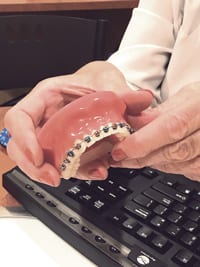Changing with the Times – Progress Brings Some New Approaches on Breast Cancer
Q: I am a 30-year breast-cancer survivor who, over the years, has attempted to keep up to date on the latest in breast-cancer treatment so that I can serve as a mentor for friends and relatives, several of whom have been diagnosed with breast cancer since my own journey began. I suffered from lymphedema after having many lymph nodes removed from under my arm. Now, I understand, that is not the case for many patients. Is that true?
A: For the past two decades, sentinel lymph-node biopsy (SLNB) has allowed doctors to avoid unnecessary lymph-node dissections for women with breast cancer that has not spread to the lymph nodes. This biopsy allows the surgeon to identify and remove just the first few lymph nodes — typically three or less — that cancer cells might travel to as their first exit point from the breast. These are axillary lymph nodes — the ones under the arm — and if no cancer is identified in those nodes, there is an excellent chance that no cancer will be found in any additional nodes under the arm. Removal of additional nodes — 10 or more in a standard axillary dissection, which it appears you underwent — leads to increasing risk of permanent arm swelling called lymphedema.
The logic of performing axillary dissections for a woman with cancer found in her sentinel nodes was that other forms of cancer treatment, such as radiation, chemotherapy, and hormone therapy, are not as effective as surgery at killing off every cancer cell in an affected lymph node. However, over the past five years, the standard of care has changed. Two large trials — called the AMAROS trial in Europe and the ACOSOG Z-11 trial in the U.S. — performed direct comparisons for women with early-stage breast cancer and positive sentinel nodes.
The studies randomly assigned these women to have either completion axillary dissections or not. All enrollees underwent radiation, and the vast majority had some form of systemic therapy, such as chemotherapy, hormone therapy, or both. While about one-third of the women who had additional surgery had more cancer found in the lymph nodes, there was no significant difference in the recurrence rates, either under the arm or elsewhere in the body, between women who had more surgery and those who did not. As a result, it has become the standard of care to now omit axillary dissection for women — those who have not undergone chemotherapy before surgery — with early-stage breast cancer and one or two positive sentinel nodes.
Q: So, does that mean that complete removal of the lymph nodes under the arm will no longer be performed on any woman?
A: Women with more advanced breast cancer, those with cancerous lymph nodes that are enlarged to the touch, and those who require mastectomy, typically still require an axillary dissection for positive nodes. However, the standard continues to change. At Baystate Medical Center, we are participating in two large, national trials looking at whether surgery and radiation are still needed for women with cancerous lymph nodes, swollen to the touch, that become normalized following chemotherapy before surgery. The hope of these trials is to show that even more patients will not require complete removal of the lymph nodes under the arm, and some may not even need radiation to that area.
Q: I also had radiation; have the guidelines changed for this treatment, too?
A: Standard breast radiation in the U.S. has traditionally been performed over five to six weeks, while in Britain and Canada, the standard has been a three- to four-week course for several decades. Recent long-term trial results from both these countries have shown this shorter course of radiation, using fewer treatments at a higher dose but the same total dose, to be just as effective and less toxic for appropriately selected women — those with early-stage breast cancer not involving the lymph nodes, who have not undergone mastectomy or been given chemotherapy. It is not advised for women under the age of 50.
Two recently published trials have indicated a minimal benefit for breast radiation in patients age 70 and over with early-stage breast cancers that do not involve the lymph nodes, and who are eligible for and actively taking hormone therapy. For these women, adding radiation to surgery and hormone therapy gives a 4{06cf2b9696b159f874511d23dbc893eb1ac83014175ed30550cfff22781411e5} benefit for local control at five years. This increases to an 8{06cf2b9696b159f874511d23dbc893eb1ac83014175ed30550cfff22781411e5} benefit at 10 years. There is no demonstrated benefit for overall survival. For many women, this low benefit is not enough to warrant the potential side effects of radiation. However, this is a very personal decision that should be made only after discussing the options with a radiation oncologist.
Q: How about chemotherapy?
A: Molecular testing now helps medical oncologists identify individuals with early-stage breast cancers who really need chemotherapy and which individuals have an excellent prognosis with hormone therapy alone. Recent studies have validated these tests and demonstrate that women with low scores do very well with hormone treatment alone. Thanks to molecular testing, doctors are now prescribing 20{06cf2b9696b159f874511d23dbc893eb1ac83014175ed30550cfff22781411e5} to 30{06cf2b9696b159f874511d23dbc893eb1ac83014175ed30550cfff22781411e5} less chemotherapy compared to 10 years ago.



Comments are closed.